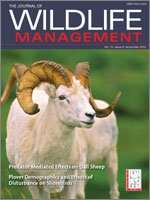Tree cavities likely vary in their thermal quality for cavity-nesting animals, which could be especially important during winter. We conducted a winter field experiment to test whether cavities vary either in their buffering capacity or in their mean temperature according to predictable characteristics. We found that cavities buffered temperature and that there was a lag effect in temperature that appeared to be related to heating and cooling. Diameter at breast height was the most important variable influencing cavity temperature during the day, with smaller trees warming up more. During the night, diameter at breast height and tree decay class were important, such that larger, live trees cooled down less. Maintaining live trees with cavities in managed forests should be considered in addition to snag retention, because live trees appear to provide warmer structures during winter.
How to translate text using browser tools
1 November 2010
Thermal Properties of Tree Cavities During Winter in a Northern Hardwood Forest
Andrea B. Coombs,
Jeff Bowman,
Colin J. Garroway
ACCESS THE FULL ARTICLE
It is not available for individual sale.
This article is only available to subscribers.
It is not available for individual sale.
It is not available for individual sale.

Journal of Wildlife Management
Vol. 74 • No. 8
November 2010
Vol. 74 • No. 8
November 2010




